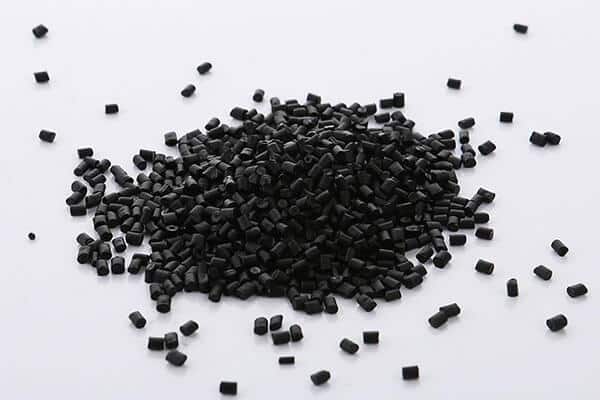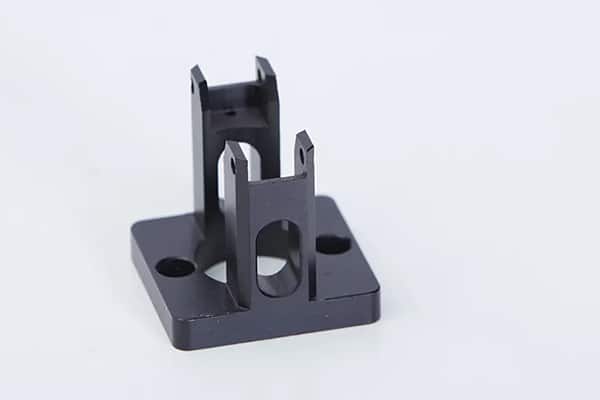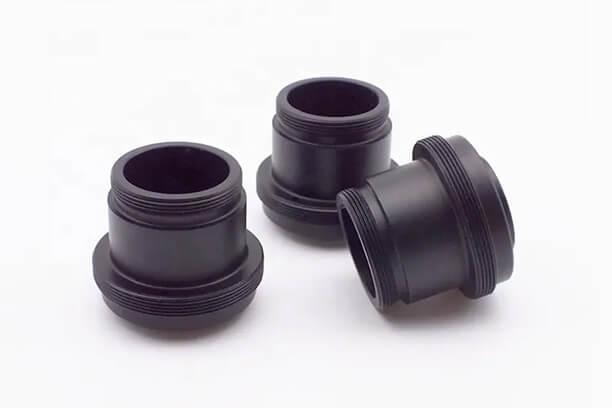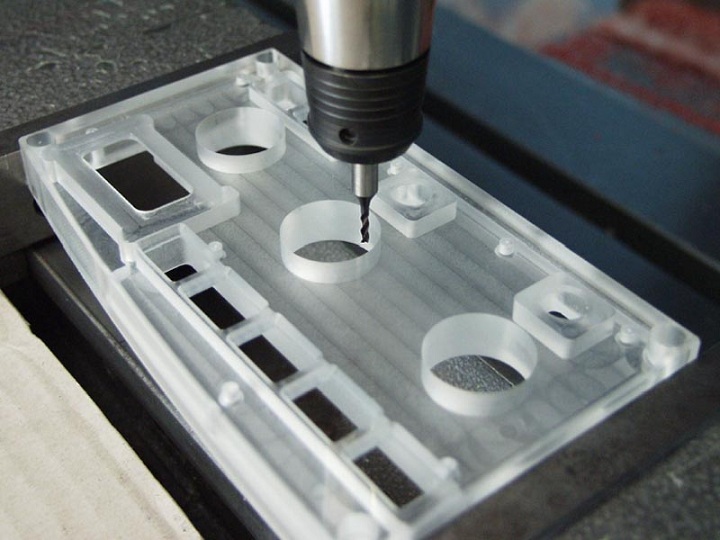POM or Delrin is an acetal homopolymer widely known for its superior durability. Its remarkable resistance to wear, creep, and warping makes it a prime option for industrial products and mechanical components. POM can be effectively machined through turning and milling processes. It may also be cut by laser, and its particles are applicable for injection molding and plastic extrusion purposes.
Complete information regarding POM characteristics, challenges and considerations in CNC machining, potential deformation, and supplementary details is provided in the following content.
What Is POM?
POM, or Polyoxymethylene, is an engineering thermoplastic material that is also known as Acetal, Delrin, polyacetal, or polyformaldehyde. It’s recognized for its exceptional stiffness, along with its ability to exhibit low friction and dimensional stability. The material has good resistance to chemicals and abrasions, and its superior rigidity leads to excellent results. The uniform molecular structure and crystalline nature give the material outstanding physical and mechanical properties, earning it nicknames such as “metal plastic” or “super steel”.
POM plastic displays an impressive range of qualities, such as outstanding colorability and comprehensive properties. It is known for its high elastic modulus, impressive rigidity and hardness, excellent tensile and bending strength, as well as remarkable resistance to creep and fatigue. With a low coefficient of friction and excellent wear resistance, this material is also highly resilient against chemicals. POM is particularly well-suited to precision machined parts and complex shapes, due to its excellent dimensional stability and limited water absorption.

Nevertheless, POM can be unstable and subject to degradation when exposed to high temperatures or acidic conditions. Its molecular structure contains a substantial amount of oxygen, which makes it challenging to enhance its flame retardancy. This material also has a continuous operating temperature range of approximately -40°C to 120°C.
POM plastic comes in two primary forms: acetal homopolymer (POM-H) and acetal copolymer (POM-C). POM-H is known for its superior hardness and stiffness, while the melting point of POM-H (172-184°C) exceeds that of POM-C (160-175°C) by approximately 10°C. The density of POM plastic ranges from 1.410-1.420 g/cm3, and it exhibits a crystallinity of 75-85%. Modified POM variants are also available, with higher melting points than the standard versions.
Pros and Cons of POM CNC Machining
In this part, we’ll discuss the characteristics of POM/Delrin/Acetal plastic for CNC machining, including its benefits and drawbacks.
Advantages of CNC POM Machining
POM/Delrin is a crystalline plastic with high performance, which makes it a feasible substitute for metal in some applications. The main advantages of POM include:
1. Heat and Electrical Insulation
With its excellent heat insulation and strong mechanical properties, POM proves to be a highly suitable material for electronic components. It has the ability to withstand considerable electrical stress, qualifying it as an ideal high-voltage insulator. Its low moisture absorption makes it an excellent option for keeping electronic components moisture-free.
2. Mechanical Strength
POM exhibits a tensile strength range of 7000-9000 psi, along with remarkable hardness and toughness. Additionally, its density is lower than that of metals, making it an alternative for making lightweight parts that require resilience against high pressure situations.
3. Fatigue Resistance
In the temperature range of -40°C to 80°C, POM displays an excellent level of durability and is highly resistant to fatigue. Furthermore, its fatigue resistance remains largely unaffected by exposure to water, chemicals, or solvents. These striking attributes render POM a perfect material for designing parts that are subject to repeated impact and stress.
4. Impact Resistance
POM possesses a remarkable level of toughness that enables it to withstand sudden impact without deflection. Moreover, its ability to resist impact can be further enhanced after being specially treated.
5. Dimensional Stability
Dimensional stability is the parameter used to evaluate a material’s capacity to maintain its original shape despite exposure to processing conditions such as temperature and pressure. POM, being resistant to deformation during machining operations, is an excellent material for attaining precise tolerances.
6. Coefficient of Friction
In a mechanical system, components in motion require lubrication to minimize friction between them. However, POM components can operate smoothly even without lubrication, owing to their innate slippery nature. This characteristic proves to be highly beneficial while designing systems where external lubrication may lead to product contamination, for instance, food processing machines.
7. Durability
Its exceptional tensile strength and durability qualify POM plastic for high-stress applications, and thus frequently used as an alternative to aluminum and steel alloys, due to its strength and resilience.
8. Moisture Absorption
POM exhibits minimal moisture absorption properties, enabling it to retain its structural integrity even under the wettest conditions or applications, i.e., underwater.
9. Creep Resistance
Due to its exceptional toughness, POM is capable of resisting significant pressure without deformation. Consequently, it is the material of choice for various industries while designing parts that require high durability and creep resistance.
Disadvantages of CNC POM Machining
Despite its higher machinability than most other plastics to make CNC machining parts, however, there are also some shortcomings of CNC POM machining:
1. Low Adhesion
Adhesives do not work well with POM because of their chemical resistance, making bonding challenging.
2. Flammability
POM does not possess self-extinguishing properties, and it will continue to burn until there is no oxygen left.
3. Sensitive to Heat
There is a risk of deformation when CNC machining POM at high temperatures.
Challenges and Tips of CNC Machining of POM
The primary issues faced during CNC machining are the deformation and cracking of the material. These problems result in two types of fractures – direct cracking during CNC machining and hidden cracks caused by internal stress. The latter slowly sneaks up and can cause significant damage, leading to complications.
Before addressing the issues mentioned above, it’s essential to discuss material selection and trial production. The use of high-quality materials can help avoid significant deformations. Therefore, it’s crucial to prioritize modified POM materials for CNC machining. POM materials may have varying qualities, and the degree of deformation is often unstable between batches due to impurities, pits, and cracks-like structures.
Regardless of the type of POM material, always conduct trial manufacture before CNC machining. It’s also necessary to perform trial manufacturing when using different batches of the same material.
Machining Tools
Due to its low hardness and small cutting force, POM can be processed using general high-speed steel and cemented carbide tools, provided they have a sharp knife edge to reduce cutting heat. PCD turning tools may also be used as an optional choice for CNC turning.
POM Processing
In case the chosen POM material is of inferior quality or if there are high dimensional tolerance requirements, it is advisable to conduct annealing after roughing to alleviate its internal stress. This method can effectively minimize deformation during the finishing process.
Process parameters provided below are solely meant for reference as there are variances in POM material types and manufacturers:
Following rough machining, POM undergoes either oil bath annealing in hot oil or air bath annealing in an oven. It is important to adjust the annealing temperature, which should be approximately 10-20°C (140-150°C) lower than the product’s heat distortion temperature. The annealing time for oil bath annealing increases by 40-60 minutes for every 5 mm of wall thickness, whereas for air bath annealing, the time increases by 20-30 minutes for every 5 mm of wall thickness. Once annealing is complete, let POM naturally cool to room temperature.
An alternative annealing technique called the “earth method” involves annealing the CNC parts at a temperature of 100°C. Once rough machining is complete, submerge the parts in boiling water for 5 to 6 hours when the ambient temperature is lower than 80°C and allow them to cool naturally to room temperature (preferably constant temperature). Alternatively, one can use the natural aging method and provide ample time for annealing.
Solutions to Deformation in POM CNC Machining
To enhance consistency in deformation and maintain tolerances within a small range, standard and consistent size of workpiece blank should be ensured when performing CNC machining.
1. Change the clamping form
When clamped, POM material undergoes deformation but will revert to its original state upon release. Increasing the contact surface of the workpiece can be achieved by modifying the clamping method, such as using bench vise cushioning or glue to fix it in place. For larger plates, ensure that they are flat before using vacuum suction cups to fix them in place. It’s advisable to fix one side with glue first, then sweep and use the suction cup to secure the smoothed surface for rough machining. In some industries, frozen suction cups are also used for fixing.
2. Reduce the cutting heat
POM material is highly susceptible to heat and can easily undergo deformation due to inadequate cooling during processing. Sharp tools should be used to minimize heat generation during cutting. Additionally, reducing the cutting amount, performing multiple cuts, and increasing the use of cooling liquids can further help to prevent overheating and quickly dissipate any heat produced during the cutting process.
3. Perform multiple cycles
POM material exhibits notable elasticity. Upon contact with the cutting tool, the material may deform inwardly, resulting in deformation of the cut and pressed part when the tool departs. Therefore, it is crucial to make multiple tool compensation adjustments based on the actual cutting effect. By dividing the cutting task into multiple cycles and reducing the amount of cutting in each pass, any dimensional deformation caused by the material’s elasticity can be minimized during processing.
4. Offset the internal stress
Due to its larger thermal expansion coefficient compared to metals, engineering plastics may undergo deformation from the elimination of internal stress when there is substantial machining allowance. To prevent this, it’s critical to correctly choose and process materials as discussed before. In cases where significant material removal is necessary, it’s advisable to use thicker material, control the margin, and adopt symmetric processing methods. Furthermore, it is important to verify that the part design itself is reasonable to mitigate any stress and deformation caused during processing.
When transferring and storing finished parts, temperature control should be prioritized to prevent deformation. It is recommended to maintain a consistent temperature, if possible. In addition, the surface of the parts should be adequately protected to prevent any scratches or damages.
Why POM Cracking in CNC Machining?
Although the degree of deformation mentioned before is a significant contributor to cracking, it is not the sole cause. The following factors may also lead to cracking in POM materials during operation:
- Large amounts of material removal during CNC machining can cause cracking in POM plastics.
- Using a larger drill bit directly to bore holes can lead to excessive cutting forces, which may squeeze and crack POM materials.
- Inadequate removal of chips while drilling deep holes during CNC machining can cause extrusion cracks when drill bits are not repeatedly retracted to remove the debris.
- Cracking may result from insufficient cooling during drilling, leading to elevated cutting heat and forces.
- High feed speed can induce inner stress in the POM material, leading to cracking.
- Failure to repair worn drill bits in a timely manner can cause the drill to harden and result in cracking while drilling POM.
Considerations for POM Machining Processes
CNC Milling and Threading
Apart from the use of different tools, the considerations for CNC milling and threading are generally alike. It’s crucial to avoid deformation while clamping, use sharp tools, set a small feed rate, and ensure adequate cooling to prevent issues during these processes.

CNC Turning
To prevent melting and wear during CNC machining, cooling is necessary. It’s advisable to prioritize solid lubrication or compressed air cooling before using coolant. Furthermore, high rotating speeds and excessive amounts of feed and engagement should be avoided. Slightly larger rake and rear angles for tools are acceptable, provided that the cutting edge remains sharp. High-speed steel turning tools are commonly used, with a rake angle of approximately 25°~40° and a rear angle of roughly 10°~20°. It is recommended to minimize the clamping force of the chuck.
Drilling
Avoid drilling directly with a large drill bit, instead, start with a small hole followed by reaming at low speed. The drill bit must be kept sharp, and the parameters for subsequent drill bits should be considered as follows: apex angle of 60°~90°, helix angle of 10°~20°, rake angle of 0°, and back angle of 10°~15°. In addition, force in the feed direction should be limited, and the tool should be retracted promptly (5~6mm deep) to facilitate cooling and chip removal while drilling. When drilling through holes, reduce the feed rate to prevent the drill bit from pushing the material in the axial direction.
Conclusion
In summary, POM or Delrin is an excellent plastic material used for CNC machining to make mechanical components and industrial products. Although POM is easy to machine, it is prone to deform during processing. However, by utilizing the recommended machining processes, including adequate cooling, reducing tool eating, and ensuring sharp tools, it is possible to minimize such deformations and other associated problems.
POM CNC Machining Manufacturer – Runsom Precision
While POM can be easily machined to make desired parts, there may also be some deformation in the CNC machining process as mentioned before. At Runsom Precision, we are an experienced manufacturer of CNC plastic parts, highly skilled in minimizing deformation and other associated challenges during POM processing. If you are looking for premium-quality POM parts, such as screws, bushes, connectors, and other customized POM components, please feel free to get in touch with us or get an instant quote online for free.
Other Articles You May Be Interested in:





